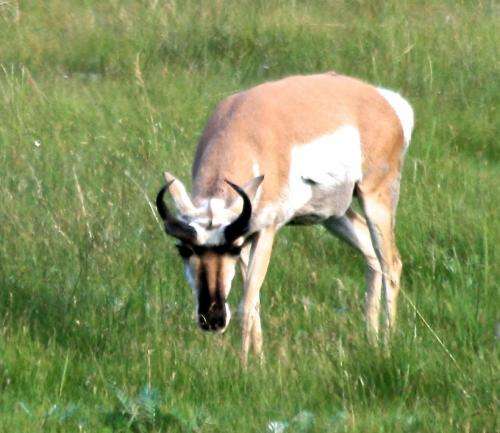Study finds herbivores can offset loss of plant biodiversity in grassland

Two wrongs may not make a right. But when it comes to grassland plant species diversity, it just might. Two impacts often controlled by humans—being fertilized and being eaten—can combine to the benefit of biodiversity, according to an innovative international study led by U of M researchers Elizabeth Borer and Eric Seabloom.
The findings, published March 9 in the online edition of Nature in advance of print publication, are important in a world where humans are changing both herbivore distribution and the supply of nutrients like nitrogen or phosphorus, and where understanding the interplay among nutrients, herbivores and plant growth is critical to our capacity to feed a growing human population and protect threatened species and ecosystems.
To conduct the study, Borer and Seabloom enlisted the help of the Nutrient Network, or NutNet, a collaborative international experiment they and a few colleagues founded in 2005 as a resource for understanding how grasslands around the world will respond to a changing environment. NutNet scientists at 40 sites on six continents set up research plots with and without added fertilizer and with and without fences to keep out the local herbivores such as deer, kangaroos, sheep or zebras. Every year since then, they have measured the amount of plant material grown, light reaching the ground, and number of species of plants growing in the plots.
When the researchers compared data across the 40 study sites, they found that fertilizing reduced the number of plant species in the plots as species less able to tolerate a lack of light were literally overshadowed by fast-growing neighbors. On both fertilized and unfertilized plots, where removal of vegetation by herbivores increased the amount of light that struck the ground, plant species diversity increased. And these results held true whether the grassland was in Minnesota, Argentina or China, and whether the herbivores involved were rabbits, sheep, elephants or something else.
"Biodiversity benefits humans and the environments that sustain us. Understanding how human actions control biodiversity is important for maintaining a healthy environment," says Borer. "What this suggests is that these two impacts, which are ubiquitous globally, dovetail with changes in light availability at the ground level, and that appears to be a big factor in maintaining or losing biodiversity in grasslands. In short, where we see a change in light, we see a change in diversity."
The findings add a key piece to the puzzle of how human impacts affect prairies, savannas, alpine meadows and other grasslands. Biodiversity plays an important role in how resilient communities of plants and animals are in the face of change. By showing how fertilization, grazing, and biodiversity are linked, the research moves us one step closer to understanding what we can do to help keep grassland ecosystems and all of the services they provide healthy and thriving in a changing world.
"Global patterns of biodiversity have largely defied explanation due to many interacting, local driving forces," says Henry Gholz, program director in the National Science Foundation's (NSF) Division of Environmental Biology, which funded the coordination of this research. "These results show that grassland biodiversity is likely largely determined by the offsetting influences of nutrition and grazing on light capture by plants."
More information: Herbivores and nutrients control grassland plant diversity via light limitation, DOI: 10.1038/nature13144
Journal information: Nature
Provided by University of Minnesota



















